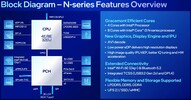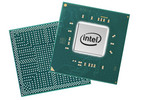Intel Processor N200 vs Intel Celeron J4115 vs Intel Core i3-N300
Intel Processor N200
► remove from comparison
The Intel Processor N200 is an entry-level mobile CPU for thin and light laptops from the Alder Lake-N series. It was announced in early 2023 and offers no performance cores and 4 of the 8 efficient cores (E-cores, Gracemont architecture). The chip does not support HyperThreading and clocks with up to 3.7 GHz. The performance of the E-cores should be similar to old Skylake cores (compare to the Core i7-6700HQ). All cores can use up to 6 MB L3-cache.
Performance
The performance is clearly lower than the Core i3-N300 and N305 due to the reduced core count. Compared to older processors, the N200 should be similar to a Core i5-8250U (4 cores with HyperThreading, 3.4 GHz, 15W) when the power limit is not restricting performance.
Features
The Alder Lake-N chips only support single channel memory with up to DDR5-4800, DDR4-3200 or LPDDR5-4800. The chip also supports Quick Sync and AV1 decoding (most likely same engine as in Alder Lake). Furthermore, Wi-Fi 6E and Bluetooth 5.2 are partly integrated (but no Thunderbolt). External chips can be connected via PCIe Gen3 x9 (via the PCH).
The integrated graphics adapter is based on the Xe-architecture and offersall 32 EUs (Execution Units) operating at only 450 - 750 MHz. Due to the single channel memory, low clock speeds and low shader count, the gaming performance of the iGPU is very limited.
Power consumption
The N200 has a base power consumption of only 6 W and is therefore suited for fanless cooling. The CPU is built with a further improved 10nm SuperFin process at Intel (called Intel 7).
Intel Celeron J4115
► remove from comparison
The Intel Celeron J4115 is a quad-core SoC primarily for inexpensive mini PCs and was announced late 2017. It runs at 1.8 GHz to 2.5 GHz (Single Core Burst) and is based on the Gemini Lake platform. Similar to the Apollo Lake predecessors, the chip is manufactured on a 14 nm process with FinFETs but offers slightly improved processor cores, double the amount of L2 cache, all in a smaller package. Partial Wi-Fi 5 support is baked into the chip. Besides four CPU cores, the chip also includes a DirectX 12 capable GPU as well as a DDR4/LPDDR4 memory controller (dual-channel, up to 2400 MHz). The processor is not replaceable as it is directly soldered to the mainboard.
Architecture
The processor architecture ist still called Goldmont Plus. Compared to the older Goldmont cores in Apollo Lake, they feature a larger L2 cache (now 4 MB). That means the per-clock-performance should be a bit better, but not anywhere near the Core CPUs like Kaby Lake Y.
Performance
The average J4115 in our database only just matches the Core i5-4260U, a somewhat more power-hungry SoC that saw the light of day in 2014, in multi-thread performance. This means the Celeron is a very basic CPU that isn't really ready to handle anything beyond the most basic tasks such as writing e-mails and listening to Spotify.
Graphics
The UHD Graphics 600 (Gemini Lake) is based on Intel's Generation 9 architecture, which supports DirectX 12 and is also used for the Kaby Lake / Skylake / Apollo Lake graphics adapters (like HD Graphics 520). Equipped with 12 EUs and a clock of up to 750 MHz, the performance should be roughly on par with the older HD Graphics 500 (Apollo Lake).
The chip also includes an advanced video engine with hardware support for the playback of VP9 and H.265 (8-bit color-depth).
Power consumption
Like most other J-class Intel processors, the Celeron has a default TDP (also known as the long-term power limit) of 10 W. This is low enough to allow laptop makers to build passively cooled laptops, mini-PCs, tablets and other gadgetry around the chip.
The Intel Celeron J4115 is built with one of the old 14 nm Intel processes for poor, as of early 2023, energy efficiency.
Intel Core i3-N300
► remove from comparison
The Intel Core i3-N305 is an entry-level mobile CPU for thin and light laptops from the Alder Lake-N series. It was announced in early 2023 and offers no performance cores and 8 efficient cores (E-cores, Gracemont architecture). The chip does not support HyperThreading and clocks with up to 3.8 GHz (single core, 3 GHz all core Turbo). The performance of the E-cores should be similar to old Skylake cores (compare to the Core i7-6700HQ). All cores can use up to 6 MB L3-cache.
Performance
The performance depends on the cooling and TDP settings and should be somewhere similar to the old Alder Lake Pentium 8500 (1 performance core, 4 efficiency cores, max. 4.4 GHz and 8 MB L3-cache). The multi-threaded performance should be quite good with the 8 cores but will suffer due to the low TDP. Single thread performance will suffer due to the missing P-cores and relatively low boost clock speeds.
Features
The Alder Lake-N chips only support single channel memory with up to DDR5-4800, DDR4-3200 or LPDDR5-4800. The chip also supports Quick Sync and AV1 decoding (most likely same engine as in Alder Lake). Furthermore, Wi-Fi 6E and Bluetooth 5.2 are partly integrated (but no Thunderbolt). External chips can be connected via PCIe Gen3 x9 (via the PCH).
The integrated graphics adapter is based on the Xe-architecture and offersall 32 EUs (Execution Units) operating at up to 1.25 GHz. In addition to the single channel memory, the gaming performance is very limited of the iGPU.
Power consumption
The i3 has a base power consumption of 7 W and is therefore even suited for fanless cooling. The CPU is built with a further improved 10nm SuperFin process at Intel (called Intel 7).
| Model | Intel Processor N200 | Intel Celeron J4115 | Intel Core i3-N300 | ||||||||||||||||||||||||||||||||||||||||||||||||||||||||||||||||||||||||||||||||
| Codename | Alder Lake-N | Gemini Lake | Alder Lake-N | ||||||||||||||||||||||||||||||||||||||||||||||||||||||||||||||||||||||||||||||||
| Series | Intel Alder Lake-N | Intel Gemini Lake | Intel Alder Lake-N | ||||||||||||||||||||||||||||||||||||||||||||||||||||||||||||||||||||||||||||||||
| Series: Alder Lake-N Alder Lake-N |
|
|
| ||||||||||||||||||||||||||||||||||||||||||||||||||||||||||||||||||||||||||||||||
| Clock | 1000 - 3700 MHz | 1800 - 2500 MHz | <=3800 MHz | ||||||||||||||||||||||||||||||||||||||||||||||||||||||||||||||||||||||||||||||||
| L3 Cache | 6 MB | 6 MB | |||||||||||||||||||||||||||||||||||||||||||||||||||||||||||||||||||||||||||||||||
| Cores / Threads | 4 / 4 4 x 3.7 GHz Intel Crestmont E-Core | 4 / 4 | 8 / 8 8 x 3.8 GHz Intel Crestmont E-Core | ||||||||||||||||||||||||||||||||||||||||||||||||||||||||||||||||||||||||||||||||
| TDP | 6 Watt | 10 Watt | 7 Watt | ||||||||||||||||||||||||||||||||||||||||||||||||||||||||||||||||||||||||||||||||
| Technology | 10 nm | 14 nm | 10 nm | ||||||||||||||||||||||||||||||||||||||||||||||||||||||||||||||||||||||||||||||||
| max. Temp. | 105 °C | 105 °C | 105 °C | ||||||||||||||||||||||||||||||||||||||||||||||||||||||||||||||||||||||||||||||||
| iGPU | Intel UHD Graphics Xe 750 32EUs (Rocket Lake) (450 - 750 MHz) | Intel UHD Graphics 600 (250 - 750 MHz) | Intel UHD Graphics Xe 750 32EUs (Rocket Lake) ( - 1250 MHz) | ||||||||||||||||||||||||||||||||||||||||||||||||||||||||||||||||||||||||||||||||
| Architecture | x86 | x86 | x86 | ||||||||||||||||||||||||||||||||||||||||||||||||||||||||||||||||||||||||||||||||
| Announced | |||||||||||||||||||||||||||||||||||||||||||||||||||||||||||||||||||||||||||||||||||
| Manufacturer | ark.intel.com | ark.intel.com | ark.intel.com | ||||||||||||||||||||||||||||||||||||||||||||||||||||||||||||||||||||||||||||||||
| L2 Cache | 4 MB | ||||||||||||||||||||||||||||||||||||||||||||||||||||||||||||||||||||||||||||||||||
| Socket | BGA1090 | ||||||||||||||||||||||||||||||||||||||||||||||||||||||||||||||||||||||||||||||||||
| Features | DDR4-2400/LPDDR4-2400 RAM, PCIe 2, MMX, SSE, SSE2, SSE3, SSSE3, SSE4.1, SSE4.2, VMX, SMEP, SMAP, MPX, EIST, TM1, TM2, Turbo, AES-NI, RDRAND, RDSEED, SHA, SGX |
Benchmarks
Average Benchmarks Intel Processor N200 → 100% n=34
Average Benchmarks Intel Celeron J4115 → 83% n=34
Average Benchmarks Intel Core i3-N300 → 120% n=34
* Smaller numbers mean a higher performance
1 This benchmark is not used for the average calculation












